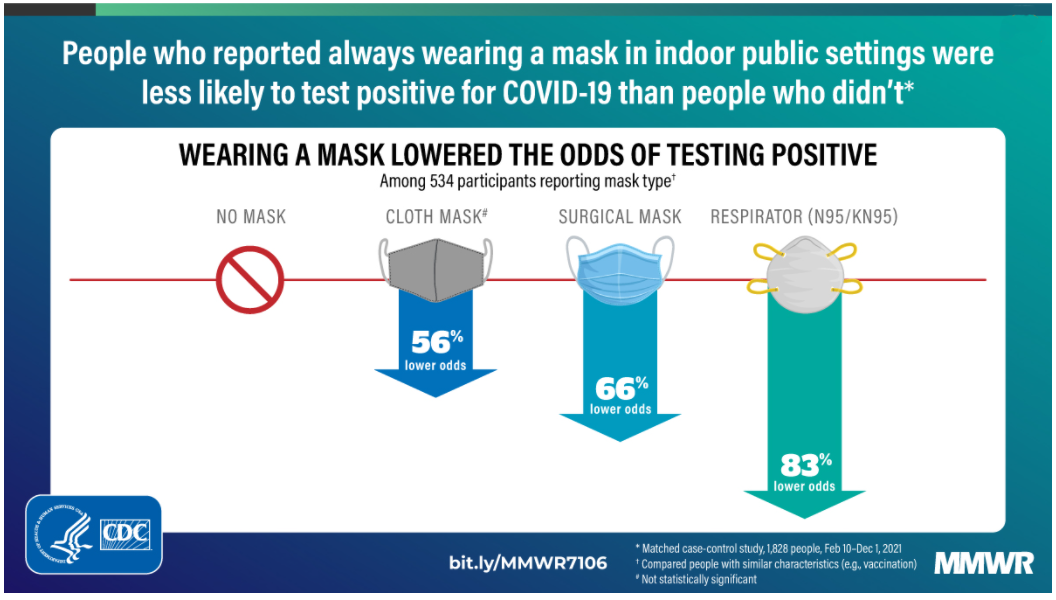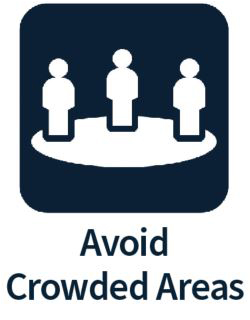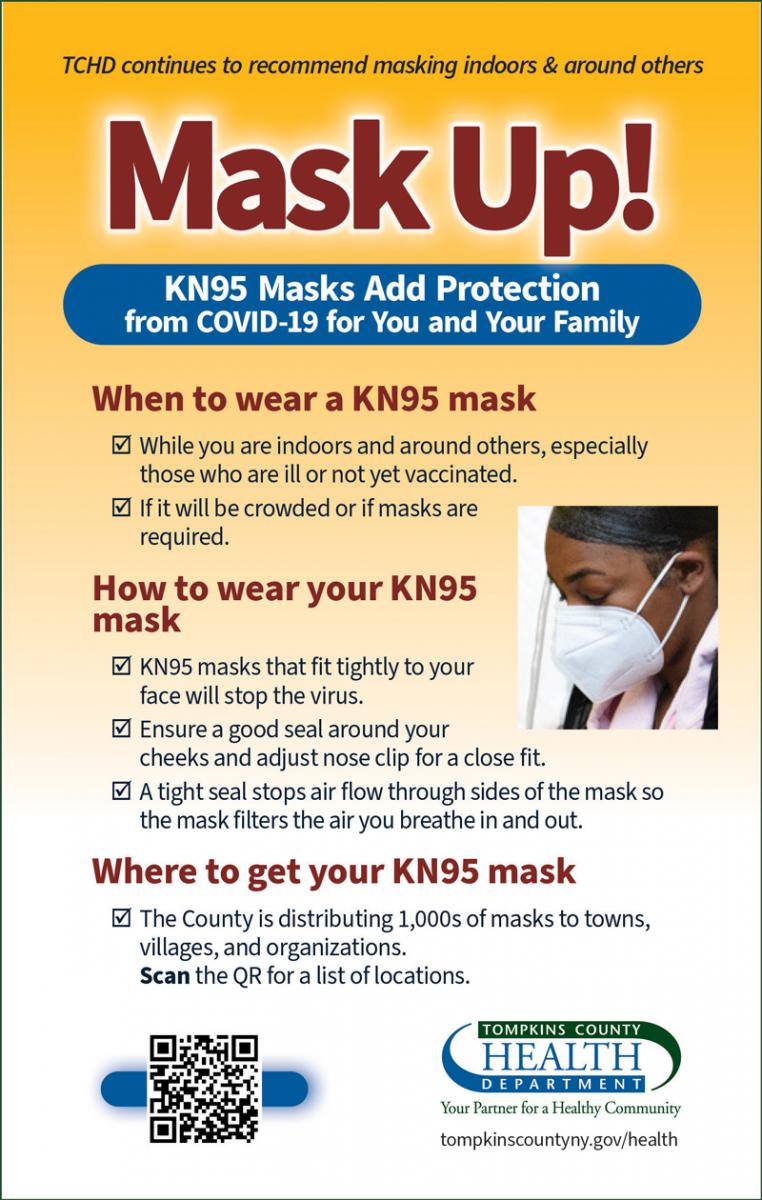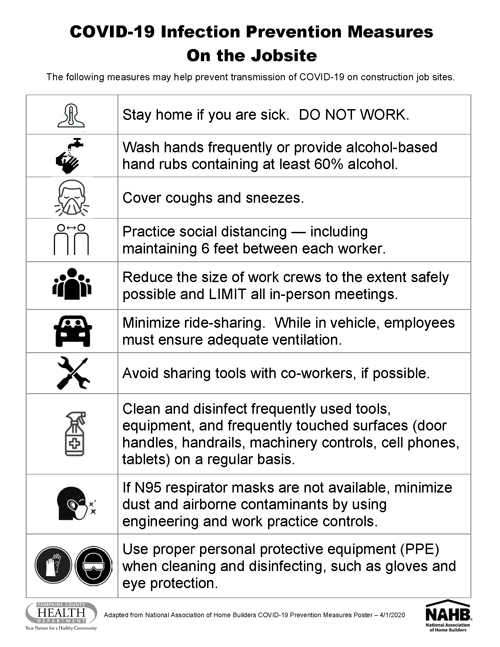This page is no longer being updated, effective 3/4/2024.
KN95 Face Masks for Adults and Youth are available, free of charge, in various locations in Tompkins County
Masks and Face Coverings
To protect yourself and others from COVID-19, the CDC continues to recommend that you wear the most protective mask you can, that fits well and that you will wear consistently.
Unvaccinated individuals over age 2 should always wear a mask when in public places and with others outside of their household.
Why Use a Face Mask
- A mask is one of the most important tools to slow the spread of the virus.
- The virus spreads mainly from person to person through respiratory aerosols and droplets produced when an infected person coughs, sneezes, talks, or raises their voice. Loud talking, shouting, and singing can increase the distance the virus spreads. This can be limited by wearing a mask. (CDC)
- In any indoor setting, everyone who wears a mask contributes to reducing the spread of COVID-19 by further limiting the potential for airborne virus.
- Studies by the CDC suggest that not wearing a mask may increase the risk of an infected person spreading the virus (1), and of a close contact becoming infected (2).
What is Acceptable as a Face Mask
- A mask should have a nose wire, and fit snugly over your nose, mouth, and chin.
- N95 and KN95 masks (respirators) provide the best protection and are widely available. These products no longer need to be reserved for health care workers and first responders.
- The effectiveness of surgical and cloth masks is limited against the Omicron variant.
- CDC image showing effectiveness of different mask types.
About KN95 Masks
- KN95 and N95 masks (respirators) use multiple layers of non-woven, electrostatically charged material that are able to trap virus particles and other air borne contaminants.
- When properly fitted and correctly worn, the KN95 mask filters out 95% of microparticles. The mask should fit snugly against your face. Check for gaps by cupping your hands around the outside edges of the mask.
- Guard against counterfeit KN95s and other respirators. Go to this page on the CDC website for more information.
- Where to get free KN95 masks provided by the Tompkins County Health Department.
- Watch this video about how to put on a KN95 to get a proper fit.
- Translations: Find our KN95 masks information card printed in 7 languages (PDFs).
Not Acceptable
- Face shields are not acceptable as a face-covering. Note that face shields may be used in addition to another mask.
- Masks with one-way valves that facilitate breathing out are not acceptable.
- Winter scarves, ski masks and balaclavas are not substitutes for masks.

Source: MMWR
Where & when to use a face mask
- Everyone both vaccinated and unvaccinated
- In areas where the community level is medium or high, or as determined by a local health advisory, wear a mask in all indoor public places.
- During periods of isolation and quarantine.
- Consider wearing a mask in a private indoor setting, including other's homes, during an uptick of cases such as from the spread of a new variant, especially if you or others are at high risk for severe disease.
- Unvaccinated individuals are expected to wear a mask in these settings
- Indoors: all indoor public places, around others who are either vaccinated or unvaccinated.
- Outdoors: crowded settings where you expect or cannot avoid close contact with others, including public events (fairs or festivals) and private parties (weddings).
- When in close contact with, or in the same room with high risk individuals (immunocompromised or have a chronic disease).
- Vaccinated individuals are advised to wear a mask
- During periods of isolation and quarantine
- If you are immunocompromised you are advised to wear a mask in indoor public settings and crowded outdoor places where close contact is either expected or cannot be avoided.
- In areas where the community level is either medium or high, as noted above for everyone.
- When required or recommended by an employer.
- When required or recommended during public transit use and in public transit waiting, ticketing, and other indoor areas associated with using public transit.
Which mask to use
A respirator (KN95 or N95) has better filtration, and if worn properly the whole time it is in use, can provide a higher level of protection than a cloth or procedural mask. A mask or respirator will be less effective if it fits poorly or if you wear it improperly or take it off frequently. Individuals may consider the situation and other factors when choosing a mask or respirator that offers greater protection. (CDC)
- When caring for someone who is sick with COVID-19.
- If you are at increased risk for severe illness, for example, people who are immunocompromised, older adults, and people with certain underlying medical conditions.
- When working at a job where you interact with large numbers of the public, especially when not everyone is consistently wearing a mask. For example, bus drivers and grocery store workers.
- When riding on planes, buses, trains, or other forms of public transportation*, especially if it is for a long period of time on crowded conveyances.
- When physical distancing is not possible or when you are in crowded indoor or outdoor public settings.
- If you are not up to date on COVID-19 vaccinations.
References
- CDC Guide to Masks
- CDC Types of Masks and Respirators
- Effectiveness of Face Mask or Respirator Use in Indoor Public Settings (MMWR, 2/4/22)
- CDC: How to select, wear, and clean your mask
- CDC: Use of masks to help prevent COVID-19
- NYSDOH: Mask & Face Coverings Guidance.
Social Distancing
Proper distancing is still one of the most important ways to prevent the spread of COVID-19.
When in public indoor places
- Keep 6 feet distance between yourself and others (that's about 2 arm lengths).
- Always follow posted requirements when in a retail location, an office, or other workplace.
- Use hand sanitizer when you enter a store or other business, and when you exit.
Higher risk individuals
- Higher risk means a greater chance of a more severe case of COVID-19 if the individual gets sick, and a better chance of having complications from the disease
- Higher risk individuals include older adults (age 60+), those who are immune-compromised, or have a chronic medical condition, especially heart disease, lung disease, and diabetes
- Higher risk individuals should avoid any in-person contact with others.
 Density
Density
When gatherings, groups, or crowds form, especially in a limited or confined space, it is important to position yourself so you can continue to maintain six feet of distance from others on all sides. If others continue to come into an area with limited space so you are unable to maintain 6-feet of distance, it is best to move to an exit or remove yourself entirely from the area. Keep an eye on things so you don't get trapped.
Additional Prevention Measures
Infection Prevention Measures On the Jobsite
- Standard workplace guidance applies, such as stay home if sick, wash hands often, cover coughs and sneezes, practice social distancing.
- Additional measures include reduce crew size to the extent possible while maintaining safety, minimize ride sharing, avoid sharing tools, clean and disinfect frequently all frequently touched surfaces, minimize dust and airborne contaminants, use proper PPE.
- Click here to download a posting sign with this information (letter-size PDF, 148KB).
References
- Cloth face masks, CDC
- Close Contact, CDC
- Interim guidance for fully vaccinated people, CDC
- Quarantine and Isolation, CDC



